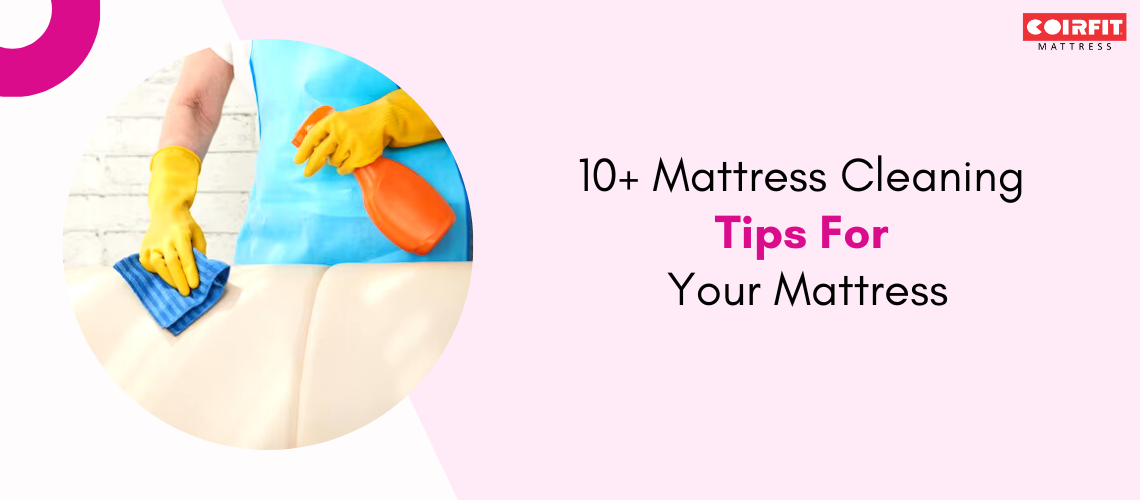

Coirfit
10+ Mattress Cleaning Tips For Your Mattress
A clean and-maintained mattress plays a vital role in our overall health and sleep quality. Our mattresses are a sanctuary, providing you with a comfortable space to rejuvenate your body and mind. In this guide, we will explore the importance of keeping our mattresses clean and delve into effective mattress cleaning, care, and maintenance techniques.
1. Understanding Mattress Cleaning
Regular cleaning of your mattress is necessary to ensure a healthy sleep environment. Over time, our mattresses accumulate common allergens, dust mites, and bacteria that can negatively impact our health. These microscopic invaders can trigger allergies, respiratory problems, and skin irritations. Deep cleaning your mattress can help alleviate these issues, allowing you to enjoy a more restful sleep.

2. Preparing for Mattress Cleaning
To begin the mattress cleaning process, remove all bedding and protection covers. This includes sheets, pillowcases, mattress pads, and mattress protectors. By removing these layers, you expose the mattress to thorough cleaning, ensuring that no hidden debris or allergens remain. Next, vacuum the mattress thoroughly using a upholstery attachment to remove loose dust, dirt, and pet hair. Pay special attention to the seams and crevices where dust mites often thrive. Finally, identify stains and spots that require special attention for effective cleaning.
3. Natural Cleaning Solutions for Mattresses cleaning
Harnessing the power of homemade cleaning solutions can be both effective and safe for your mattress. One such solution is a mixture of white vinegar and water, which is known for its antibacterial properties. Tea tree oil, when mixed with water, can also act as a natural disinfectant. Odors can be eliminated by sprinkling baking soda over the mattress and allowing it to sit for a few hours before vacuuming. Using eco-friendly alternatives instead of harsh chemicals benefits both your health and the environment.
4. Using Commercial Mattress Cleaners
There is a wide range of commercial mattress cleaners available in the market, each with its unique set of features. When choosing the right cleaner for your specific needs, consider factors such as the type of stains you need to tackle and any specific requirements for your mattress material. Follow the step-by-step instructions provided by the manufacturer to ensure effective usage of the product. Additionally, be mindful of any warnings or precautions mentioned on the packaging.
5. Spot Cleaning Techniques
Treating common stains on your mattress, such as blood, urine, or sweat, requires specific techniques. For effective stain removal, enzyme cleaners can be highly effective. Enzymes break down the protein molecules found in these stains, making them easier to remove. Remember to blot the stain rather than scrub it, as scrubbing can cause the stain to spread. For stubborn stains or discoloration, a mixture of hydrogen peroxide and dish soap can be used to target and remove the blemish.
6. Deep Cleaning Methods for Mattresses Cleaning
Deep cleaning your mattress is essential to eliminate deep-seated dirt, allergens, and bacteria. One effective method is steam cleaning, which uses hot water vapor to penetrate the mattress and kill bacteria and dust mites. Another option is dry cleaning, which involves using an absorbent compound that is spread over the mattress and then vacuumed up, taking dirt and allergens with it. If your mattress requires professional attention, consider hiring a certified mattress cleaning service for a thorough and comprehensive cleaning.

7. Maintaining Mattress Hygiene
Maintaining proper mattress hygiene includes regular rotation and flipping. This simple task helps distribute weight evenly and prevents sagging. Using mattress protectors adds an extra layer of cleanliness and protection, shielding your mattress from spills, stains, and allergens. It is also advisable to maintain a clean sleeping environment by regularly washing your bedding, keeping pets off the bed, and avoiding eating or drinking in bed. These practices help extend the lifespan of your mattress and ensure a healthier sleep environment.
8. Proper Mattress Care
Preventative measures are crucial for keeping your mattress clean. Use a mattress cover as a barrier against allergens, dust mites, and stains. Remove any stains promptly to prevent them from setting in. Regularly vacuuming your mattress and implementing good ventilation in your bedroom can minimize allergen buildup. Additionally, periodically airing out your mattress by opening windows or using a fan can help eliminate any trapped odors.
9. Addressing Mattress Smells
Unpleasant odors in your mattress can disrupt your sleep and overall comfort. Identifying common odors and their causes is the first step in eliminating them. To deodorize your mattress, sprinkle baking soda generously over the surface and allow it to sit for several hours before vacuuming it up. The baking soda will absorb any lingering odors, leaving your mattress smelling fresh. To prevent odors from recurring, keeping your mattress clean and using a mattress cover act as a protective barrier against sweat, dead skin cells, and spills.
10. Mattress Maintenance Tips
Over time, mattresses may develop sagging or indentations that affect comfort and support. To address mattress sagging, consider using a mattress topper or padding to provide extra support. Fluffing and smoothing mattress toppers, pillow tops, and any integrated padding can restore their plushness. In case of minor damages or tears in the mattress fabric, use fabric repair kits to fix them promptly. Taking care of these maintenance tasks can extend the lifespan of your mattress and maintain its quality.
11. Seasonal Cleaning and Storage
Deep cleaning your mattress on a seasonal basis helps eliminate accumulated dirt and allergens. A thorough mattress cleaning should be performed before storing your mattress during periods of non-use. This involves vacuuming, spot-cleaning any stains, and allowing the mattress to fully dry before storage. When storing your mattress, make sure it is placed in a clean, dry, and well-ventilated area. Cover the mattress with a breathable, moisture-resistant cover to protect it from potential damage.
12. Bed Bug Prevention and Control
Bed bugs pose a significant risk to our mattresses and overall sleep experience. Understanding the signs of a bed bug infestation is crucial for prompt action. Look for small, dark spots on your mattress or bedding, as well as any signs of live bugs. Preventing and eliminating bed bugs effectively involves a combination of thorough cleaning, regular vacuuming, and maintaining a clean sleeping environment. In severe cases, professional extermination services may be necessary to ensure complete eradication.
Mattress Care for Different Types of Mattresses
Different types of mattresses require specific care instructions to optimize their lifespan and performance. Memory foam mattresses should be rotated regularly to avoid compression and sagging in specific areas. Latex and hybrid mattresses benefit from being aired out periodically to prevent moisture buildup. Traditional spring mattresses and other types may require different maintenance techniques such as flipping or replacing worn-out coil systems. Always refer to the manufacturer’s instructions for the best care practices specific to your mattress type.

Common Mistakes to Avoid
While maintaining your mattress, it is essential to be aware of common mistakes that can compromise its cleanliness and health. Avoid using excessive amounts of water or cleaning solutions, as this can lead to mold and mildew growth. Harsh scrubbing or using abrasive tools can damage the mattress fabric or deform its structure. Additionally, using strong chemical cleaners can release harmful fumes into the air and adversely affect your respiratory health. By being proactive and informed, you can prevent these issues and maintain a healthy mattress.
Frequently Asked Questions (FAQs)
What is the recommended frequency for mattress cleaning?
Regular mattress cleaning is recommended every six months to maintain a clean sleep environment and prevent the build-up of allergens and bacteria.
Can I machine wash my mattress cover?
Machine washing your mattress cover depends on the manufacturer’s instructions. Some covers are machine washable, while others may require spot cleaning or professional cleaning.
How often should I replace my mattress?
It is generally recommended to replace your mattress every 8 to 10 years or when it no longer provides adequate support and comfort.
Is professional mattress cleaning worth the cost?
Professional mattress cleaning can be worth the cost, especially for deep cleaning and removing stubborn stains or odors. Professionals have specialized equipment and expertise to ensure a thorough cleaning without damaging your mattress.
Conclusion
Regular mattress cleaning, care, and maintenance are vital for a healthier sleep environment and improved sleep quality. By following the techniques outlined in this guide, you can enjoy a clean and comfortable mattress while reducing the risks of allergens, bacteria, and other contaminants. Remember that proper care and maintenance contribute to the longevity of your mattress and ultimately contribute to a more refreshing and rejuvenating sleep experience.
If you are looking to exchange your old mattress in India, we suggest you try Coirfit Maha Exchange Offer from https://www.coirfitmattress.com/
know more about Coirfit Updates and Sleep Tips, Binge on-

To know more about Coirfit Updates and Sleep Tips, Binge on-
- Diwali Mattress Buying Guide: Upgrade your sleep with Coirfit
- Celebrate This Diwali by Investing in a Coirfit mattress
- Importance of Mattress Size: Finding the Perfect Fit for Your Space
- The Real Truth About Sleep
- Why You Should Listen To India’s First Sleep Podcast
- How Your Mattress Affects Your Spine and Posture

















